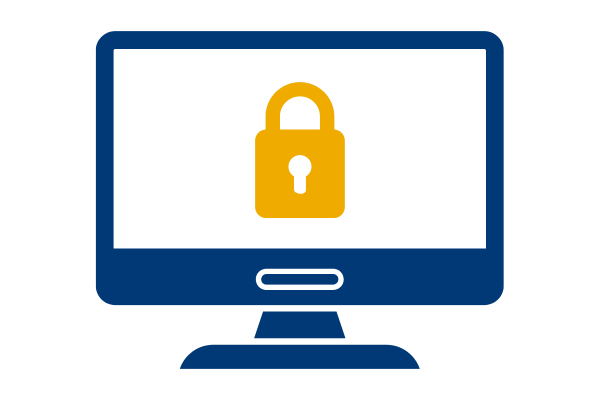Phishing and Scams
Phishing is a form of social engineering delivered by email. Phishing scams appear to originate from a trusted source to trick you into entering your credentials, revealing personal identifying information (PII), or sending money to them.
The attacker can then use this information to access your accounts, gather additional private information about you in an attempt to steal your identity, and make purchases or apply for credit in your name.
You can learn more about phishing and social engineering by reading the information here.
Phishing Tips
- Move your mouse over links in emails and it may show a different URL than the one displayed.
- If you are encouraged to click a link that claims to lead to a legitimate site (such as Amazon), look online for a trusted URL leading to that site instead.
- Check the sender address to verify that the email comes from an official source.
- Check for slight mispellings - in the URL, company name, etc. For example, paypa1.com instead of paypal.com.
- Use additional software - Many browsers have add-ons/extensions/plug-ins that can help detect phishing sites.
- Be wary of anything that gives a sense of urgency, or states that it requires immediate action.
- Don't click anywhere in suspicious emails—even in what may appear to be white space.
- Be wary of too-good-to-be-true offers such as free airline tickets or vacation.
- Don’t open attachments in unexpected or suspicious emails or instant messages.
- Don’t send passwords, bank account numbers, or other private information in an email.
Note that Kent State will NEVER ask for your password through email.
For more advice on how to avoid phishing scams, visit our Fight the Phish page!
Have I Been The Victim Of A Phishing Scam?
If you believe that you have been the victim of a phishing scam, change your password immediately and report it to phish@kent.edu or submit a support ticket. Also, don't forget to check out our account security article for tips on how to keep your accounts safe. If you are using Gmail, you can also end all other active sessions. This should stop any unauthorized access to your account. Instructions on how to end active session in Gmail can be found here. You can also end active sessions in Outlook by following the instructions here.
When a victim of a phishing scam, it's common practice for the hackers to change your signatures, forwards, filters, and other settings. If you believe you fell victim to a scam, we recommend checking the following settings in your mail client.
- A signature for an email is text that is automatically inserted at the end of an email. It is usually something you choose to set up. Make sure it is not an unfamiliar one setup.
- Forwards can be set up to automatically forward to another email address. Make sure it is not forwarded to unknown address without your permission.
- Inbox rules/filters can be used to automatically sort or delete anything in your inbox or sent box etc. Scammers can use it to re-direct/hide their messages.
- Check all of the folders in your email account - sometimes the malicious actor may create new folder to store messages they sent/receive or put them into the Trash when using your account to perform scams.
What Are Scams?
Scams come in many forms and are a type of social engineering to either gain your personal identifiable information (PII), or steal your money. They are getting more and more sophisticated, particularly when it comes to targeting you online and through mobile devices. It’s important to know how to recognize a scam so you can protect yourself from fraudsters.
Note that KSU will NEVER ask for your password through e-mail, so be wary of anything that says otherwise.
Please report any scams you receive to phish@kent.edu. You can learn about additional ways to report phishing scams here: Report Phishing
How To Detect a Scam?
- Scammers pretend to be from organizations you know
- They pretend that you won a prize or that there is a problem
- Scam calls will usually pressure you to act immediately
- If it sounds too good to be true, then it probably is
- Scammers will tell you to pay in a specific way
Steps To Avoid Scams
- Don’t give out any personal information
- Resist pressure
- Block unwanted calls or messages
- Don't click on any pictures, links, or white spaces in a suspicious email
- Stop and talk to someone before taking action or giving out any information
Please refer to the Federal Trade Commission (FTC) site to read more about common scams and how to report them.
You'd better watch out! 'Tis the season for scams.
HOLIDAY SCAMS ON THE NAUGHTY LIST:
It's always a scramble to find the perfect gift in time for the holidays. Keep in mind - just like the Grinch sitting high up on his mountaintop keeping his eyes on the little town of Whoville, cyber criminals are watching and ready to scam you! Many of us will shop online in search of great deals and to avoid noisy crowds. Unfortunately, cyber criminals will be active as well, creating fake shopping websites and using other tactics to scam people.
With many items being in high demand and slow shipping, you may find yourself in more of a hurry than normal to do your holiday shopping. Unfortunately, this creates the perfect storm for a cyber criminal. They use manipulation tactics and prey on emotions, trying to get your credit card numbers, login credentials and other personally identifiable information (PII)!
How to avoid holiday scams

- Check every website's URL to make sure that it's legitimate. NEVER enter any sensitive information to a website that does not contain "https" in the web address.
- Research any company that you don't normally do business with. Check for reviews across the internet.
- Use a unique password for each of your online accounts.
- If you purchase from auction or marketplace sites, check the account selling an item. Look for a large number of bad reviews, or no reviews. Always be suspicious of new accounts.
- Always get tracking numbers so that you can monitor the shipping and delivery process.
- Never wire money directly to a seller.
- Do not pay with pre-paid gift cards unless the gift cards are specifically for the site you're buying from.
- Regularly monitor your credit statements for suspicious charges. Contact your credit card company if anything looks out of the ordinary.
- If something is too good to be true, it probably is!
Holiday Scams
Around the holidays, scammers get creative with their tactics! Click a topic below to learn about the most common scams of the holiday season, and how to recognize them.
Types of Phishing and Scams
Scammers will use many different methods to try and trick you into giving them important information. Click one of the topics below to learn more about phishing techniques, common scams, and additional advice to help keep yourself safe!









